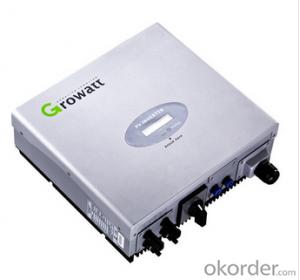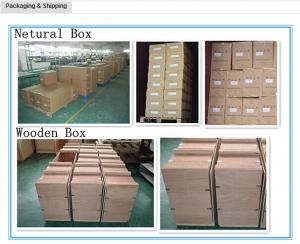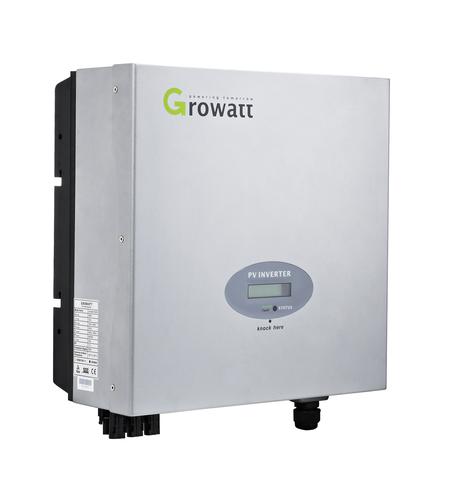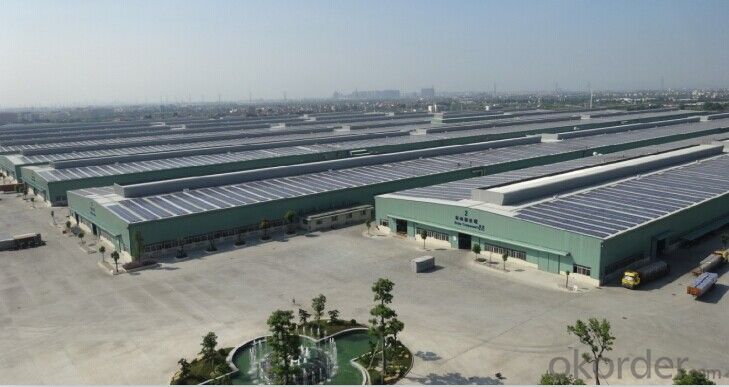Best Rv Solar Inverter 4000W-5000W Grid Connected Solar System
- Loading Port:
- Shekou
- Payment Terms:
- TT or LC
- Min Order Qty:
- 10 pc
- Supply Capability:
- 10000 pc/month
OKorder Service Pledge
OKorder Financial Service
You Might Also Like
Grid Connected Solar inverter 4000W-5000W
Maximum efficiency of 97.8% and wide input voltage range
Internal DC Switch
Transformerless GT topology
Compact design
MTL-String
Bluetooth/ RF technology/ Zigbee/ Wi-Fi
Sound control
Easy installation
Comprehensive Growatt warranty program
Maximum efficiency of 97.8%
wide input voltage range
Internal DC Switch
Transformerless GT topology
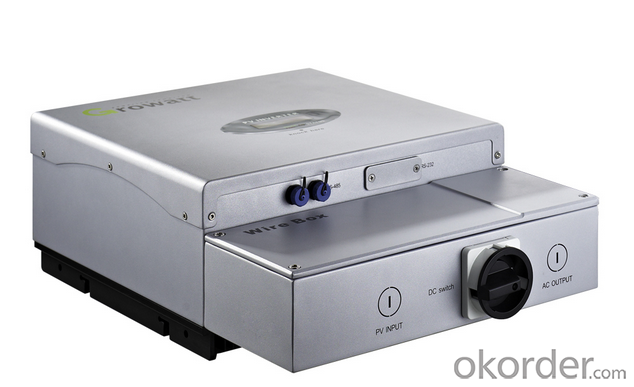
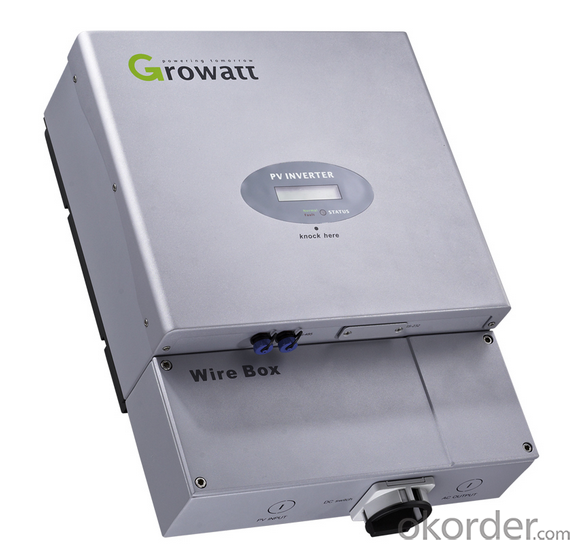
Communications
> RS485 /GPRS interfaces
> Computer monitoring software
Safety
> Full protection functions:DC reverse polarity, AC short-circuit protection, ground fault monitoring, grid monitoring, integrate all-pole sensitive, leakage current monitoring unit.
> Standards complied: EN61000-6-1, EN61000-6-2, EN61000-6-3, EN61000-6-4,EN61000-3-2, EN50178, VDE0126-1-1,IEC-62109
Technical Specifications
4000TL | 4400TL | 5000TL | |
| Inputdata | |||
| Max.DCpower | 4600W | 5000W | 5800W |
| Max. DC voltage | 580V | 580V | 580V |
| StartVoltage | 120V | 120V | 120V |
| PV voltage range | 90V-580V | 90V-580V | 90V-580V |
| MPP voltage range/ Nominal voltage | 95V-580V/360V | 95V-580V/360V | 95V-580V/360V |
| Full load DC voltage range | 250V-500V | 250V-500V | 250V-500V |
| Max. input current/ per string | 20A/20A | 20A/20A | 20A/20A |
| Number of independent MPP trackers /strings per MPP tracker | 1/3 | 1/3 | 1/3 |
| Efficiency | |||
Max.efficiency | 97.8% | 97.8% | 97.8% |
| Rated AC output power | 3680W | 4200W | 4600W |
| Max. AC power | 4000W | 4400W | 5000W |
| Max. output current | 16A | 21A | 25A |
| AC nominal voltage; range | 220V/230V/240V 180Vac-280Vac | 220V/230V/240V 180Vac-280Vac | 220V/230V/240V 180Vac-280Vac |
| AC grid frequency; range | 50Hz, 60Hz;±5Hz | 50Hz, 60Hz;±5Hz | 50Hz, 60Hz;±5Hz |
| Power factor | 1 | 1 | 1 |
| THDI | <3% | <3% | <3% |
| AC connection | Single phase | Single phase | Single phase |
| Protection Devices | |||
| DC reverse polarity protection | yes | yes | yes |
| DC switch rating for each MPPT | yes | yes | yes |
| Output over current protection | yes | yes | yes |
| Output over voltage protection-varistor | yes | yes | yes |
| Ground fault monitoring | yes | yes | yes |
| Grid monitoring | yes | yes | yes |
| Integrated all-pole sensitive leakage current monitoring unit | yes | yes | yes |
| Generaldata | |||
Dimensions(W/H/D) in mm | 406/406/192 100% | 406/406/192 21KG | 406/406/192 |
| Features | |||
DC connection AC connection Display Warranty: 5years/10years | H4/MC4(opt) Screw terminal LCD yes/opt | H4/MC4(opt) Screw terminal LCD yes / yes / yes/opt | H4/MC4(opt) Screw terminal LCD yes / yes / yes/opt |
| Certificates and ApprovalsCE, VDE 0126-1-1, DK5940, G83, G59, RD1663, EN50438, IEC 62109, ENEL-Guide |
- Q: How does a solar inverter handle voltage sags or swells in the grid?
- A solar inverter handles voltage sags or swells in the grid by continuously monitoring the grid voltage. When a sag or swell is detected, the inverter adjusts its output voltage accordingly to maintain a stable and consistent supply of power. It does this by regulating the amount of power it injects into the grid or by temporarily disconnecting from the grid to protect itself and other connected devices. This helps to prevent damage to the inverter and ensures that the solar system can continue operating efficiently even during voltage fluctuations.
- Q: After the PV inverter, how to achieve the same period before the network?
- Solar panel simulator: with MPPT function, simulated morning, noon, afternoon, evening, rainy weather, solar panels produced under different conditions in different voltages.
- Q: Can a solar inverter be used in a solar-powered air conditioning system?
- Yes, a solar inverter can be used in a solar-powered air conditioning system. A solar inverter converts the direct current (DC) produced by solar panels into alternating current (AC), which is required to power most appliances including air conditioning units. By using a solar inverter, the solar energy generated by the panels can be efficiently utilized to run the air conditioning system, reducing reliance on the electrical grid and lowering energy costs.
- Q: Can a solar inverter be used in a community solar project?
- Yes, a solar inverter can be used in a community solar project. In fact, a solar inverter is an essential component of any solar power system, including community solar projects. It converts the direct current (DC) electricity generated by the solar panels into alternating current (AC) electricity that can be used to power homes and businesses in the community. The solar inverter also helps regulate the flow of electricity and ensures the system operates efficiently.
- Q: Are there any maintenance requirements for solar inverters?
- Yes, solar inverters do require regular maintenance to ensure optimal performance and longevity. This can include cleaning or replacing air filters, inspecting and tightening electrical connections, checking for any physical damage or corrosion, and updating firmware or software as needed. Additionally, monitoring the inverter's performance and generating reports can help identify any issues or inefficiencies that may require maintenance or repairs.
- Q: What is the role of a solar inverter in a solar-powered remote monitoring system?
- The role of a solar inverter in a solar-powered remote monitoring system is to convert the direct current (DC) electricity generated by the solar panels into alternating current (AC) electricity that can be used to power the monitoring system. It also ensures that the electricity generated matches the requirements of the monitoring equipment, regulates the voltage, and assists in efficient power transmission and distribution.
- Q: What is the maximum efficiency of a solar inverter?
- The maximum efficiency of a solar inverter typically ranges from 95% to 98%.
- Q: Can a solar inverter be used with a smart home system?
- Yes, a solar inverter can be used with a smart home system. Many modern solar inverters have the capability to integrate and communicate with smart home systems through protocols such as Wi-Fi, Bluetooth, or Zigbee. This integration allows users to monitor and control their solar energy production, consumption, and other related parameters using their smart home system's interface or mobile app.
- Q: Can a solar inverter be used with a solar-powered food dehydrator?
- Yes, a solar inverter can be used with a solar-powered food dehydrator. A solar inverter is responsible for converting the direct current (DC) generated by solar panels into alternating current (AC) that is suitable for powering household appliances. Since a food dehydrator operates on AC power, using a solar inverter allows the solar energy captured by the panels to be utilized effectively in powering the dehydrator.
- Q: What is the maximum DC input voltage for a solar inverter?
- The maximum DC input voltage for a solar inverter typically depends on the specific model and manufacturer. However, in general, the maximum DC input voltage for a solar inverter can range from around 500 volts to 1000 volts or more. It is important to consult the manufacturer's specifications for the specific solar inverter being used to determine the exact maximum DC input voltage.
Send your message to us
Best Rv Solar Inverter 4000W-5000W Grid Connected Solar System
- Loading Port:
- Shekou
- Payment Terms:
- TT or LC
- Min Order Qty:
- 10 pc
- Supply Capability:
- 10000 pc/month
OKorder Service Pledge
OKorder Financial Service
Similar products
Hot products
Hot Searches
Related keywords


